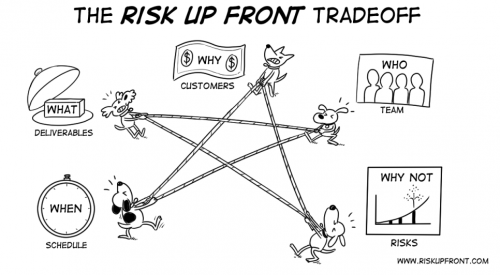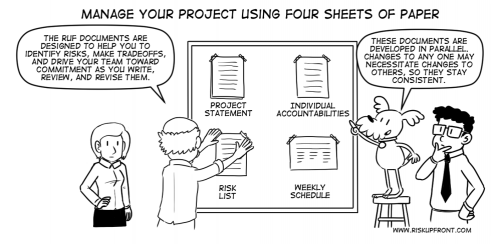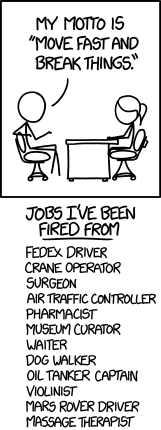by Mek & Pallavi Devaraj
This is the first installment of an interview series called, “To the World” which goes behind the scenes to explore what inspires authors to write and share their work with the world.
In this interview, we receive a master class on effective project management by Brad Rubenstein, co-author of Risk Up Front.
Introducing Brad Rubenstein
 Brad Rubenstein has been, at times, a software developer and systems architect, a classical musician, a project manager, and a theatre and indie film producer. Most recently, he is co-author, with Adam Josephs, of the project management bible, Risk Up Front: Managing Projects in a Complex World (RUF). RUF is a treasure trove of resources Brad and Adam produced as a reference guide for their clients at Celerity Consulting, a boutique project management consulting firm. In his free cycles, Brad volunteers as an advisor for Open Library, where his book has been put to use countless times.
Brad Rubenstein has been, at times, a software developer and systems architect, a classical musician, a project manager, and a theatre and indie film producer. Most recently, he is co-author, with Adam Josephs, of the project management bible, Risk Up Front: Managing Projects in a Complex World (RUF). RUF is a treasure trove of resources Brad and Adam produced as a reference guide for their clients at Celerity Consulting, a boutique project management consulting firm. In his free cycles, Brad volunteers as an advisor for Open Library, where his book has been put to use countless times.
Growing up in Southeast Asian, Brad describes himself as a third culture kid.
“My childhood was in Thailand and Indonesia”, Brad says, “I came back to the United States to study computer science, just as Silicon Valley was taking off.”
After finishing a PhD at U.C. Berkeley, Brad cut his teeth in Silicon Valley as an early employee at Sun Microsystems. In the ’90s, he moved to New York to design and develop the distributed trading and risk management infrastructure employed by Goldman Sachs as they automated their operations. Since leaving Goldman in 2000, Brad transitioned into a project coaching and team building role as a co-founder of Celerity consulting where he has spent nearly two decades sharing his expertise with a wide variety of for-profit and non-profit organizations on how to get things done.
“Nothing teaches you how to run complex projects better than actually running complex projects.”
So, you’ve done projects all your life and for the first time you are being asked to do a project which is bigger than a single person can do. Maybe the solution is not obvious. It’s too complex to keep in your head or it requires you to make difficult choices.
One of the most important assets a project manager can bring to the table is wisdom and experience from having gone through many projects and seeing where things went wrong or right. But someone who is new to project management may not have these first hand experiences to call upon. The first question many of us have is, “Where do I start?”
“Teams are much more comfortable solving the problems they know how to solve.”
Many of us instinctively start by tackling the problems we know how to solve and trying to build momentum. Instead of letting ourselves get blocked, there is an impulse to move fast and break things; to follow the path of least resistance and get something working. Maybe this means working on the easy stuff first, or getting the difficult stuff out of the way, or maybe even ramping up on the most interesting stuff.
“It’s unnatural, but critical,” Brad advises, “for project teams to talk about how their project might get derailed and proactively mitigate those risks early, rather than letting them strike later when changes are most expensive. Although projects seem to have a logical order in which it makes sense to get the pieces done, we encourage teams to focus on doing the risky parts first, which sometimes takes a bit of creativity (and scaffolding).”
“You can’t do a risk-reward trade-off if the risks are hidden in your blind spot.”
Many teams, especially startups in Silicon Valley, feel pressure to move quickly and are more open to taking risks. Brad suggests this may be fallacy:
“When people talk about risk and reward, there is a presupposition that one understands what the risks are in order to take them. The Risk Up Front method focuses on helping teams become aware of the risks in the first place, so they can make sensible decisions about how to prioritize and mitigate them. As you come up with a list of risks articulated in a way that moves the team to take action, you might choose to leave them and place your bets. The trouble is when teams are blindsided by an expensive risk late in the game that they wouldn’t have taken had they known about it earlier.”
“The fact that an individual knows something is different than a team knowing something.”
We asked Brad how someone who is new to project management is supposed to magically be able to anticipate what could go wrong on a project.
“There’s a better question a project manager in this situation might ask”, Brad says, “How do I create the space in my team to reliably surface the things that might go wrong? This space does not happen by accident. You have to make it happen.”
Whether you’re new to project management or a veteran, Brad emphasizes the value of leveraging the experience and expertise of ones teammates. The wisdom of the whole team is greater than the sum of its parts. So what does Risk Up Front look like and how does it happen?
Brad explains, “Many engineers may be familiar with the concept of an Agile stand-up. In Risk Up Front we have Weekly Accountability Meetings (WAM) where the project’s full cross-functional team accounts for their progress, commits to what they’ll do next week, and matches this with what they’ve finished, so the team can ensure commitments are being kept and forward progress is being made.”
A key element of the WAM is a Risk Review where a crucial question is posed to each member of the team in turn:
“What is the most likely reason this project will fail?”
Going around on a regular basis and asking this one question creates the space to uncover hidden issues and moves the team to act.”, Brad says. “A central part of RUF is making sure the right questions get asked.”
“If your project has too many risks, it’s time to evaluate your Project Definition.”
We wondered what advice Brad would give to a team if they discover their project has too many high risks:
“In Risk Up Front, projects begin with a series of Definition Meetings that force the team to arrive at a mutual agreement as to how they will trade off the 5 W’s — who, what, why, when, and why-not (i.e. the risks) of the project, in order to settle on a project that the team can commit to deliver. A lot bends during these discussions. You might change what you decide to build, change who you build it for. All of these choices will have consequences and risk profiles. Perhaps building for one audience means building fewer components which might mean less risk. The outcome of such a meeting is a project definition statement whose risks your team is comfortable accepting.”

“Are you afraid something is going to go wrong?”
Something we imagine Brad gets asked frequently is, what are early warning signs, before a disaster occurs, that might clue someone in that they need his help? Brad tells us that Celerity is commonly brought into a project after a big disaster.
“People who are new to managing big projects may not know they need something like Risk Up Front and thus don’t call us at the beginning. Looking on the bright side, one advantage of this is that teams in this situation are often malleable and willing to put new processes in place after something has gone awry.”
Brad mentions that recognizing small process failures early on, such as not rigorously following through on commitments, falling behind schedule, or experiencing integration issues of the work product of teammates, are great opportunities to use techniques from the book to course correct.
“4 principles, 4 pieces of paper, and 2 meetings.”
Risk Up Front includes 4 documents with instructions, including a Risk Action Plan, to help teams methodically surface risks out of blind-spots through targeted conversation.
Brad notes, “It is the process of negotiating the elements of these documents within the team that is valuable, not the documents themselves. In a sense, the paperwork is the booby prize. We want to keep it as simple as possible.”

“Successful projects depend more on your team’s behavior than on their project tools.”
There are a lot of books about project management out there. We wondered what motivated Brad and Adam to write Risk Up Front.
Although certain tools and methods are more appropriate for certain types of projects and teams, we repeatedly see projects with first-class tools and methods get into trouble. On the flip side, we’ve seen complex projects succeed with the barest of project management tools — often no more than a few spreadsheets, lists, and documents.
p. xvi Risk Up Front
“The prosaic reason is that it makes teaching our method to teams a lot easier (they can use the book as a reference), and my favorite work is with the teams themselves. But we do get calls from individuals in far-off places telling us they’re using RUF for projects that have never crossed our paths before, which is very gratifying.”
Before writing “Risk Up Front”, we wondered if there was a book Brad turned to for answers.
“When I was in college, I had to facilitate large and boisterous board meetings run according to Roberts Rules of Order, and that was an education. At the time, I read How to Make Meetings Work (Michael Doyle, David Strauss, 1976), and that made a big impression. The skills I learned about facilitating meetings, helping people in the meeting actually get something done, have served me well.”
“Every project is different in the details, but people are people”
We ask Brad, if he were to invest time in another guide, if he would go deeper into risk mitigation or focus on demystifying another complimentary area of project management:
“The book [RUF] is very good at laying out the philosophy and why it hangs together. There’s a difference between presenting theory and facilitating practice. For example, we describe in detail how to do a weekly accountability meeting and yet it’s not easy for people having read the book to run a weekly accountability meeting because it takes practice and thought to line everything up and turn it into a routine. I think simplified checklists of instructions and suggestions would make it easier for readers to use our documents and put the theory of Risk Up Front into practice.”
The simple but powerful idea of formalizing a project management methodology into easily applicable checklists is an idea which is celebrated in Atul Gawande’s Checklist Manifesto, and a prospect that is very exciting to the Open Library Team.
Risk Up Front & Open Library
We ask Brad how he became an advisor to the Open Library project:
“I met Mek Karpeles, who heads up the Open Library project, earlier in 2019, at a Grand Re-opening of the Public Domain celebration hosted by the Internet Archive in San Francisco. He was one of the presenters. I had just finished my book, and was exploring what was next for me. He was looking for someone to help get the process of wrangling their open source development workflow, along with a group of enthusiastic volunteers, running more smoothly. Mek had big plans for new features at Open Library, including a Book Sponsorship project, that would allow Open Library users to help underwrite the acquisition of new books that others could borrow directly from their web site. I was fascinated by it, and it seemed like a fun and interesting place to plug in. Mek offered to scan in a copy of Risk Up Front himself (in return for my autograph on the frontispiece), and add it to the library.”

You can read more about Open Library’s Book Sponsorship program on Open Library’s blog https://blog.openlibrary.org/2019/10/23/scan-on-demand-building-the-worlds-open-library-together/ or learn how to participate here: https://openlibrary.org/sponsorship.

“I am a big fan of libraries, and openlibrary.org is the biggest library. So I’m thrilled [for my work to be available on the website].”
Brad remarks that he is drawn to the importance of Open Library’s long term vision, “[…] to make all the published works of humankind available to everyone in the world.” A vision he hopes will long outlast his work, and even those of the current core team. In order for this to be true, Brad believes the right architectures and a culture need to be in place to keep patrons and contributors excited about their progress toward this vision. Open Library is also a great case study of “Risk Up Front” and an opportunity for Brad to apply the lessons of his book directly to help a team faced with big decisions and challenges. For instance, like meeting the difficulties of coordinating a geographically distributed team like Open Library’s.
We asked Mek Karpeles, Open Library’s program lead and Brad’s mentee, if he’s found Brad’s book applicable to problems Open Library faces:
For me and Open Library, I have to admit, it was as simple as, “how do I run a meeting?”. How many times have I taken notes at a meeting and never opened them up again? This was a clear indicator that my notes or meetings are not structured correctly, but I had never asked why. As our advisor, Brad directed us to ask fundamental questions we had taken for granted. Like, “Who are these meeting minutes for and what purpose do they serve?”.
Each of our community calls now starts with short updates from each teammate. As soon as a point seems too long, we add it to a list of Open Mic topics we’ll discuss after the updates are finished. And we have a section in our notes dedicated to decisions and action items. Brad’s book has a great template for understanding what an action item is; what will be delivered, who owns it, and by when (explicitly not how). We take our notes in google docs and use the comment feature to assign each decision to a member of our team. Sometimes, these involve a next step of creating issues on our GitHub bug tracker. Brad’s book helped us keep our weekly meeting useful.
The Risk Up Front book includes a handful of Project Documents and templates which represented hidden opportunities for us. The ‘Team List” document — having an inventory of stakeholders and the projects they lead — in particular was a big win for us. The exercise helped us realize the benefits of delegation by encouraging members of the community to publicly step up and commit to owning parts of the project, and at the same time helping community members know where to direct their questions. We have our Team List posted publicly on our wiki.
Beyond the Book
Outside of being an expert project manager and an author, we wondered how Brad would like to be remembered:
“I don’t want to bill myself these days as an expert project manager (any more than the coach of the basketball team is necessarily the best basketball player). I have fallen into the coaching role, which helps me develop my skills in listening and noticing what stands in the way of people being great, along with some strategies for helping people get that stuff out of their way. Many folks do that with individuals – I’m focused on doing it for groups or teams. My passion is for getting things that are stuck, unstuck. In the unlikely event that I’m going to become famous, I guess I’d hope to be famous for that.”
As a final question, we asked Brad, what is one thing you wish more of the world knew or thought about more? And why is this important to you or us?
“Tough question. Groups of people can accomplish great things that no single person can accomplish, and they can also spin horribly out of control in ways an individual never would. In this particular moment, it seems valuable to keep both these things in mind.”
Thank you
Open Library offers a deep thank you to Brad Rubenstein for his contributions to Open Library, his commitment to sharing knowledge, and for his patience answering our questions.
If you liked these tips and are interested in putting Brad and Adam’s process into practice, pick up a copy of Risk Up Front and let us know what you think by tweeting @RiskUpFront.
Want to hear more from Brad? Check out this other interview on Green Planet Blue Planet:


Insightful comments on effective project management!